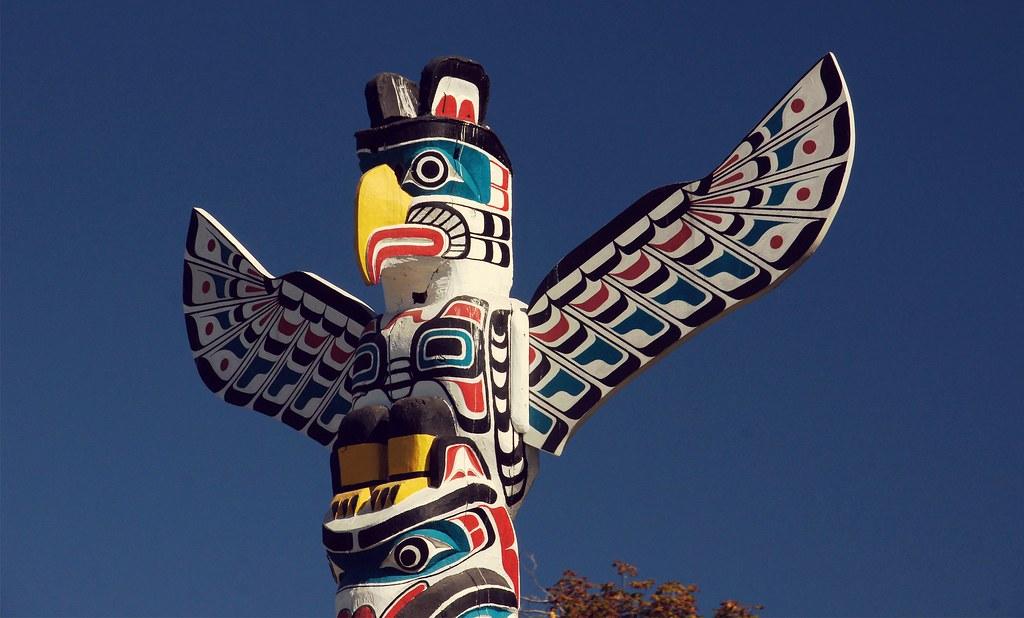Tasks: Totem by Thomas King

- If you were to enter a Canadian art museum looking for art that was authentically Canadian and that presented Canadian identity, what would you expect to see?
- This short story takes place in The Southwest Alberta Art Gallery and Prairie Museum. What kind of art is displayed in the museum?
- How would you describe the characters in the story? (Beebe Hill, Walter Hooton, Larue Denny, and Jimmy) Who do they represent in Canadian society?
- What, or who, do the totem poles represent?
- There are several symbols used in the short story. Are you able to find the symbolic meaning of:
- the totem pole itself?
- where the totem poles are placed in the room?
- the fact that the story takes place in a museum?
- the act of cutting down the totem poles?
- the repeated reference to the 'lack of space' for the totem poles and the fact that they are placed in the basement?
- the noise the totem poles are making?
the fact that they grow back every time they are cut down?
The Canadian Constitution recognises three groups of Aboriginal peoples: First Nations, Inuit, and Métis. These are three distinct peoples with unique histories, languages, cultural practices, and spiritual beliefs.
Terminology can sometimes be tricky to navigate - who do the terms include? And which terms should be avoided?
Take a look at the terms below. Write down your definition of each. Then check your answers with the key below.
- Aboriginal
- First Nation
- Inuit
- Native American
- Indian
- Métis
- Indigenous
- Mrs Hill is very upset about her visit to the museum. She decides to write a letter to the museum director where she complains about a "disturbing element in the exhibition". Write the letter of complaint.
- Write an analysis of the short story 'Totem' where you focus on the use of symbols and metaphors in the story. Use references from the text to support your argument.
Read for information:
Learn more about the First Nations and cultural assimilation.
Use the websites below (and others that you may find useful) and find out more about the following:
- What does the term 'to assimilate' mean?
- Explain what the so-called Indian Problem was.
- What was the aim of the Indian Act of 1876 ? What did the Canadian government do to achieve this aim?
- Explain what a reserve is. Do you know the difference between a reserve and a reservation?
- Explain what a Residential School was. What was the aim of the schools, and how were the children treated in these places?
Suggested websites:
- link to the Government of Canada's webpage about First Nations in Canada
- link to the organisation Facing History and Ourselves' article about assimilation
- link to the article 'Racial Segregation of Indigenous Peoples in Canada', on the webpage The Canadian Encyclopedia
- link to the BBC article 'Canada mourns as remains of 215 children found at indigenous school'
Read for information:
Learn more about the present-day socio-economic conditions for First Nation people.
Use the websites below or other internet sources, and find out more about the following:
- income level, employment, and education level
- general housing and living conditions
- health issues among First Nation people
- the situation for First Nations in the criminal justice system
Suggested websites:
- link to article 'Social Conditions of Indigenous Peoples in Canada' on the webpage the Canadian Encyclopedia
- link to article '8 key issues for Indigenous Peoples in Canada' on the webpage Indigenous Corporate Training.
- link to article 'First Nations (Socio-Economic Conditions)' on the webpage the Canadian Encyclopedia
Relatert innhold
The short story Totem by Thomas King discusses the conflict between First Nation people and the dominant Western culture in Canada.